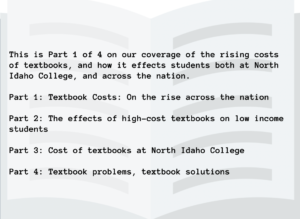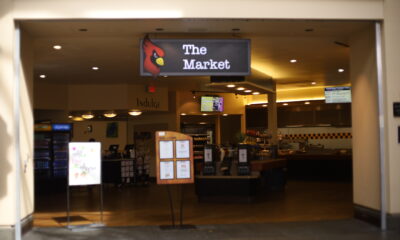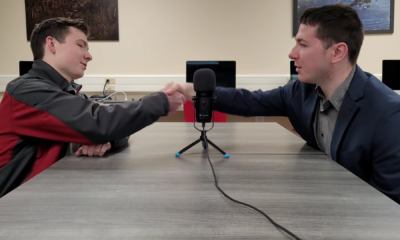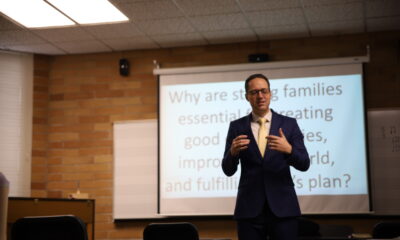Features
Textbook Costs: On the rise across the nation

Conclusion First
The cost of textbooks has risen significantly in the past few decades, despite little to no increase in the cost of publishing these books. Arguably, it is cheaper now to publish a 600 page textbook than it was at the end of the 1970s. New methods of printing (particularly digital) have driven down the cost per page that publishers pay for printing, yet the price handed down to students continues to rise with each passing year. There is a difference of roughly $200 per semester spent by 2 year vs 4 year students on their textbooks, with 2 year students spending that extra $200 a semester. Despite claims made (in 1975) that marginal profits are at or near 15.8% for a book that succeeds for how many copies were printed and sold, the same cannot be said for present day. The cost of printing has dropped almost in tandem with the rise in cost of textbooks. Why then are we paying between 800 and 1,200 percent more than our counterparts did in the mid to late 70s? Inflation, books falling short of sales minimums, publishing house mergers, the advent of digital books/digital distribution methods, online shopping, and pure greed.
Since our last report in 2016 on the cost of textbooks at North Idaho college, there has been a sharp rise in their cost – both new and used.
The total amount spent on textbooks per semester for students is thought to be between $1,220 (private 4 year schools) and $1,420 (2 year schools). Though these prices can vary, and there are other factors at play here (I.e. 4 year schools tend to cost more in tuition and lab fees than 2 year schools do), the fact of the matter is that this boils down to students paying far more now, than there fathers and grandfathers once did, even when adjusted for inflation.
For some context here, a hypothetical textbook that in the 70s would have cost $10 then, whereas now, that “same” textbook would cost $56 in 2022, before being marked up by the bookstore. Inflation between these two periods has reached roughly 400 percent. Now, a real textbook that would have cost a student $10 in the mid to late 70s now costs roughly $80-200 brand new. This is quite the difference.
One explanation for this could very well be the cost of printing having gone up. Another is the shift from more center-based education to standardized methods of learning. Journalist Phillip Whitten, when writing for “The Annals of the American Academy of Political and Social Science” in 1975, states that fixed and variable costs would lead to a mere 15.8% margin. This is declared to be an acceptable profit amount, given that not every book will come anywhere close to commanding this profit amount. Whitten follows this with another example of the same book making the publisher lose $126,000 if the book sold just 10,000 copies, rather than 20,000.
Whitten further notes that the publishing space had become increasingly competitive. One can easily argue this to be truer today than it was during his time. With the advent of many east coast publishers buying up smaller publishing firms, we are able to see how competitive practices via fewer options can, and is playing out. While the proposed merger of Simon and Schuster with Penguin might not raise eyebrows for academic textbook publishers; if it follows the merger between Penguin and Random House, prices will be driven up on both fiction and nonfiction alike, which will cause a potential increase in the price of textbooks.
The advent of digital books (ebooks) can also in some capacity be blamed for the increase in price. However, despite claims by many proponents of ebooks, their price is not necessarily cheaper than print books. Yes, it costs little to nothing to distribute ebooks compared to print books, yet their prices are somewhat comparable to print books. “Histology: An Essential Textbook” by Lowrie costs $59.99 at list price as an ebook, and $69.99 as a print book. Is there truly a justification for this? This cost difference is incredibly common, especially for textbooks and nonfiction works alike. This brings up the age old debate of whether or not we pay for the materials, or the information within.
Online shopping can partly be blamed for the rise in cost as well. When most things that were not once available where you live, suddenly come online, it opens up a whole new universe of possibilities. This includes finding a better price on something (in this case – textbooks) than you might be able to find locally. This causes price increases amongst book and mortar stores, even if they want to compete, their overhead prevents them from doing so. This makes mom and pop shops more vulnerable to being priced out of their markets, which allows conglomerates to gobble up their physical sales if they are unable to lower prices. While those conglomerates are able to maintain lower prices due to their size and purchasing power, those online prices will typically be cheaper, especially for used books. The sale of used books was once relegated to in person, but now, anyone can sell a book online. The availability of thousands of different textbooks and non-textbooks on websites like Ebay, Amazon, and AbeBooks (also owned by Amazon) from sellers like ThriftBooks, WorldofBooksUSA, and second.sale for under $5.00 a book drives up the price of books at brick and mortar stores, because their is less demand for those books being bought in person versus on the web.
Greed is perhaps the biggest contributing factor to the cost of books, particularly in college bookstores. When a bookstore purchases a book for $10.00 and sells it for $30, that makes sense. That bookstore needs to cover their overhead (base cost, cost of their space, staff, etc.), as well as needing to make a modest profit for them to stay in business. Yet, when they sell that same book for 3 times that – God forbid 10 times that – THAT is pure greed on their end.
Citations:
Infographic: Textbook Costs Skyrocket 812% in 35 Years (aeseducation.com)
Why Poor Schools Can’t Win at Standardized Testing – The Atlantic
The Rising Cost of College Textbooks – BookScouter Blog
Fixing-the-Broken-Textbook-Market (pirg.org)
The Rising Cost of Textbooks in the US – The Cooper Point Journal (bingj.com)
Why are textbooks so expensive? – Vox
The Consolidation of Publishing Houses, Past and Present


















